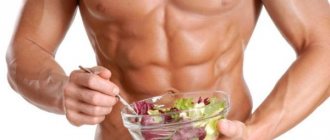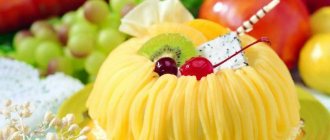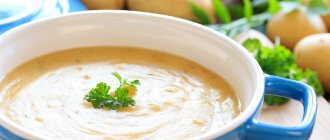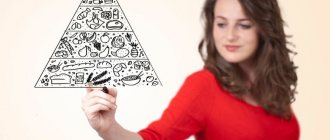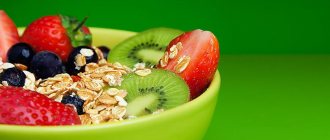Dr. Lydia Ionova, the author of the popular diet, has published a new book, this time with recipes. We will certainly introduce you to them, but first we suggest that you learn to calculate what and how much to eat to lose weight or maintain a weight that suits you. So, what habits do we need to eat properly and lose weight?
Varied and healthy food
Why is diet diversity an important eating habit? It is variety, and not the absence of tasty things, that is one of the main principles of healthy eating. A varied menu not only provides you with vitamins, minerals, amino acids and other essential nutritional factors, but also serves as a guarantee of your commitment to a healthy diet in the future and the prevention of breakdowns. After all, only a variety of food does not become boring, does not cause boredom and the desire to pamper yourself with something tasty, which was usual before the program (depending on gastronomic preferences, sweets, baked goods, fast food, sausage, etc. can act as tasty food).
Who is Dr. Ionova
Lydia Ionova, who created a carefully developed nutrition plan, is a nutritionist, the author of her own weight loss method and the founder of Dr. Ionova’s clinic. Today she is on the list of the most sought-after nutritionists in Moscow according to Forbes. In 2009, Lidia Ionova became the first nutritionist from Russia to undergo training at the School of Obesity Treatment (Cambridge).
Subsequently, she published several of her own books, which are designed to help those who want to lose weight lose extra pounds. In addition, Lidia Ionova is a permanent consultant to leading Russian television channels, among which are Russia 1, Channel One, NTV, etc. She also has a large number of participations in foreign and Russian scientific congresses dedicated to dietetics.
Drinking regime
A person weighing, say, 80 kg needs 2.8 liters of fluid. When forming this habit, the main task is to gradually, over the course of several weeks, increase the amount of water consumed per day to the norm - 35 ml per kilogram of weight.
This recommendation is for people with healthy kidneys. If you have any problems with the urinary system, be sure to consult your doctor! If you find it difficult to drink the required amount of water, start drinking clean water before meals and between meals. In addition, you should give up sugary drinks and juices (including freshly squeezed ones), replacing the latter with whole fruits, since their glycemic index is much lower.
Advantages and disadvantages
The Ionova diet has many advantages:
- The balance of beneficial macro- and microelements is maintained, which avoids the problem of a lack of certain vitamins and minerals (this problem is relevant for many diets that are compiled by non-professionals).
- The diet is very well accepted on a psychological level, and its use will not lead to stress.
- There are no contraindications or side effects. This diet can be used for diabetes, gastrointestinal diseases, and so on.
- The diet is completely healthy, so it improves your well-being and results in a comprehensive recovery of the body.
- The diet is effective against any degree of obesity. Research shows that it can be used to cope with both advanced obesity and mild obesity of the first degree.
The only drawback of the Ionova diet is that it allows you to lose about 4-7 kg per month (while some other diets allow you to achieve more impressive success).
It should be noted that Ionova’s diet differs from other diets in that it allows you to stably fix your weight, which not all diets can boast of.
Availability of all product groups
Your diet only has a chance of becoming balanced when it contains the following food groups every day:
- Protein products
- Starchy foods
- Fruits
- Vegetables
- Fats
There is also a group of dairy products, and in his book “Healthy Habits. “Dr. Ionova’s diet” I included it in the list of mandatory ones for daily consumption. But scientific developments in the field of nutrition are ongoing, and recently studies have appeared that talk about the possible negative consequences of regular consumption of dairy products, especially for men. Therefore, until absolute clarity appears on this issue (if it ever appears!), I excluded the group of dairy products from the mandatory ones.
Let me remind you that in addition to milk, dairy products include kefir, yogurt, fermented baked milk, and yogurt.
The main task before you is to include all five food groups in your daily meal. In this case, your diet will be balanced.
The protein group includes all foods containing large amounts of protein. These are various types of meat and fish, cottage cheese, cheese, eggs, legumes (beans, peas, lentils). Protein group products are the main source of complete proteins. They contain the entire set of amino acids necessary for the construction and renewal of cells in the human body.
Starchy foods include bread and baked goods, cereals, pasta, legumes (since they contain both protein and carbohydrates), and vegetables - potatoes. The main purpose of products in this group is to supply the body with energy.
The group of fruits includes, of course, the fruits themselves, as well as berries, fruit juices and dried fruits.
The group of vegetables , of course, includes all types of vegetables (including leafy ones, such as salads, spinach, etc.), and mushrooms. Vegetables and fruits are the most important suppliers of mineral salts (especially potassium salts), a number of microelements, organic acids and fiber.
The group of fats includes healthy vegetable fats: all types of oils (sunflower, olive, soybean, pine nuts and walnuts, flaxseed, etc.), nuts and seeds.
Of course, this group also includes animal fats, but since we strive to reduce their consumption to a minimum, there is no need to specifically add them to the diet.
Ionova’s diet, reviews from doctors and specialists
Like any other nutrition system, Ionova’s diet has a number of reviews from doctors and nutrition specialists.
Karina Nikolaevna Smolina, nutritionist
Dr. Ionova’s technique is considered one of the best and deservedly so. It is quite easily tolerated, completely safe for health and gives a stable, long-term result. In principle, there is no need to leave the Pyramid diet - there is no sudden transition to normal nutrition. The only thing that is missing from the sample menu proposed by Ionova’s clinic is first courses, although when creating your own diet, you can easily replace boiled meat with lean soup with the same meat (though you will have to cook it without vegetables). And one more thing: an active lifestyle, as a factor in losing weight, has not been canceled. To burn calories, you need physical activity. Not necessarily grueling workouts in the gym, but at least light gymnastics, walking, swimming.
Ivan Sergeevich Dobrynin, nutritionist
The Pyramid diet contains the principles of today's popular separate nutrition, the benefits of which were described by Herbert Sheldon a century ago. An alkaline environment is required for the absorption of carbohydrates, and proteins are better broken down in an alkaline environment. When consumed together, the acidic and alkaline enzymes released to digest them will neutralize each other, slowing down the digestion process.
Unlike other methods for losing weight, where the whole day is allotted for one product, in the Ionova diet you can eat carbohydrates, fats, and proteins throughout the day, giving them only the time necessary for complete digestion. In addition, proteins and carbohydrates should be consumed at a time when they are better absorbed by the body: cereals in the morning, meat and milk in the afternoon, vegetables and fruits in the evening.
Of course, the best results can be obtained by taking a weight loss course at Lydia Ionova’s Moscow clinic, where an individual program is developed for each patient and the weight loss process is monitored. But by using this technique on your own, it is quite possible to gradually lose excess weight, without harm to the body.
Sources:
- https://pohudejkina.ru/dieta-ionovoj.html
- https://vfigure.ru/populyarnye-diety/drugie-populyarnye-diety/piramida-pitaniya-i-dieta-ionovoj.html
- https://HudeiSkorei.com/dieta-ionovoj/
- https://medside.ru/dieta-doktora-ionovoy
Balanced diet
In addition to the presence of the main five food groups in the diet, a certain ratio between proteins, fats and carbohydrates is necessary. Even if you get a minimal amount of calories, but most of them come from fats and in addition there is a deficiency of essential substances, then such a diet, of course, can lead to weight loss, but, unfortunately, it will result in loss of health.
In order to determine not only the quality, but also the quantity of food, I suggest you “build” your own food pyramid. In other words, you need to determine in what quantities foods from each group should be present in your diet. For convenience, we will measure the amount of food in dietary portions.
Step #1: Calculate your daily calorie intake
Find the formula in the table below that corresponds to your age and gender, make the necessary calculations, then multiply the resulting number by the physical activity coefficient. This will be the number of calories you need every day.
Recommended calorie intake
Physical activity rate:
Sedentary lifestyle - X x 1.1.
Moderate physical activity - X x 1.3.
Heavy physical work - X x 1.5.
For example, let’s calculate the normal calorie intake for a 35-year-old woman who leads a sedentary lifestyle and weighs 70 kg:
(0.0342×70 +3.5377) x 240 = 5.9317×240 = 1423.6
1423.6 × 1.1 = 1566 kcal.
Step #2: Do the calculations only if you want to lose weight. If you are of normal weight, feel free to skip this step!
So, the calorie intake required for weight loss is calculated as follows: subtract 20% from the result obtained in the first step. But in order not to lose your health along with the extra pounds, remember: a woman should consume at least 1000-1200 kcal per day, and a man - at least 1200-1500.
Let's continue the calculations for a 35-year-old woman weighing 70 kg, for whom the normal caloric intake is 1566 kcal per day:
20% of 1566 is 313 kcal.
Thus, the caloric content of the diet for weight loss:
1566 - 313 = 1253 kcal.
Advertising
Step No. 3. How to “build” a food pyramid?
Determine the required number of servings by food group for your daily diet and build your food pyramid.
Food pyramid for weight loss
That is, for our “exemplary” lady with a calorie diet for weight loss of 1253 kcal, it makes sense to stick to the number of servings for 1200 kcal - in the middle column. If your caloric intake for weight loss is, for example, 1100 kcal, take an average number of servings between 1000 and 1200 kcal.
Food pyramid for weight maintenance
You can combine products from all groups and eat them at any time. The only group where there are restrictions, and then only if you are losing weight, are starchy foods. During weight loss, I recommend eating them before dinner, that is, for breakfast and lunch. And if you maintain the results and maintain a normal weight, you can eat them at any meal.
Advertising
Lidia Ionova's diet menu for the week
1 day
6.00-11.00 A plate of oatmeal with salt and a piece of butter. 1 glass of water. 11.00-14.00 A small piece of boiled fish with salt. 14.00-17.00 150-200 gr. low-fat or low-fat cottage cheese. 1 glass of milk. 17.00-19.00 2 oranges, 2 apples. 19.00-23.00 2 raw carrots, grated. If you wish, you can add half a teaspoon of fructose (in no case with sugar!).
Day 2
6.00-11.00 A plate of buckwheat porridge with salt. 11.00-14.00 1 glass of water. 200 gr. boiled chicken breast with salt. 14.00-17.00 2 jars of yogurt. 17.00-19.00 4-5 tangerines. 19.00-23.00 Salad of 3 tomatoes with any herbs of your choice, a pinch of salt and half a teaspoon of olive oil.
Day 3
6.00-11.00 A plate of pearl barley porridge with salt and a piece of butter. 1 glass of green tea without sugar. 11.00-14.00 1 glass of water. 200 gr. boiled beef with salt. 14.00-17.00 1 glass of kefir. 17.00-19.00 3-4 persimmons. 19.00-23.00 Salad of 3-4 cucumbers with herbs and salt.
4 day
6.00-11.00 A plate of oatmeal with salt and a piece of butter. 1 glass of black tea without sugar. 11.00-14.00 200 gr. boiled skinless chicken. 14.00-17.00 2 glasses of milk. 17.00-19.00 3 apples, grated. If desired, you can add 1 teaspoon of fructose (but not sugar!) 19.00-23.00 1/4 medium head of white cabbage, shredded.
